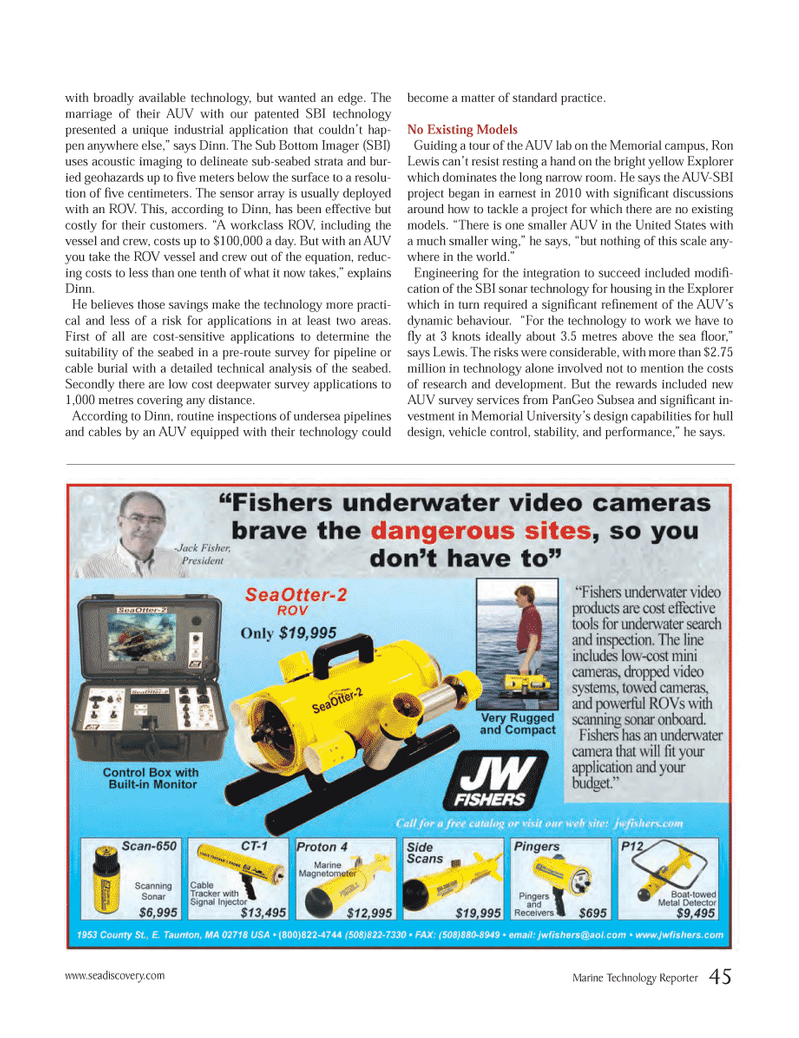
Page 45: of Marine Technology Magazine (June 2012)
AUV Arctic Operations
Read this page in Pdf, Flash or Html5 edition of June 2012 Marine Technology Magazine
with broadly available technology, but wanted an edge. The marriage of their AUV with our patented SBI technology presented a unique industrial application that couldn?t hap- pen anywhere else,? says Dinn. The Sub Bottom Imager (SBI) uses acoustic imaging to delineate sub-seabed strata and bur- ied geohazards up to ve meters below the surface to a resolu- tion of ve centimeters. The sensor array is usually deployed with an ROV. This, according to Dinn, has been effective but costly for their customers. ?A workclass ROV, including the vessel and crew, costs up to $100,000 a day. But with an AUV you take the ROV vessel and crew out of the equation, reduc- ing costs to less than one tenth of what it now takes,? explains Dinn. He believes those savings make the technology more practi- cal and less of a risk for applications in at least two areas. First of all are cost-sensitive applications to determine the suitability of the seabed in a pre-route survey for pipeline or cable burial with a detailed technical analysis of the seabed. Secondly there are low cost deepwater survey applications to 1,000 metres covering any distance. According to Dinn, routine inspections of undersea pipelines and cables by an AUV equipped with their technology could become a matter of standard practice. No Existing ModelsGuiding a tour of the AUV lab on the Memorial campus, Ron Lewis can?t resist resting a hand on the bright yellow Explorer which dominates the long narrow room. He says the AUV-SBI project began in earnest in 2010 with signi cant discussions around how to tackle a project for which there are no existing models. ?There is one smaller AUV in the United States with a much smaller wing,? he says, ?but nothing of this scale any- where in the world.? Engineering for the integration to succeed included modi -cation of the SBI sonar technology for housing in the Explorer which in turn required a signi cant re nement of the AUV?s dynamic behaviour. ?For the technology to work we have to y at 3 knots ideally about 3.5 metres above the sea oor,? says Lewis. The risks were considerable, with more than $2.75 million in technology alone involved not to mention the costs of research and development. But the rewards included new AUV survey services from PanGeo Subsea and signi cant in- vestment in Memorial University?s design capabilities for hull design, vehicle control, stability, and performance,? he says. Marine Technology Reporter 45 www.seadiscovery.com MTR #5 (34-49).indd 45MTR #5 (34-49).indd 455/31/2012 10:27:18 AM5/31/2012 10:27:18 AM

 44
44

 46
46
